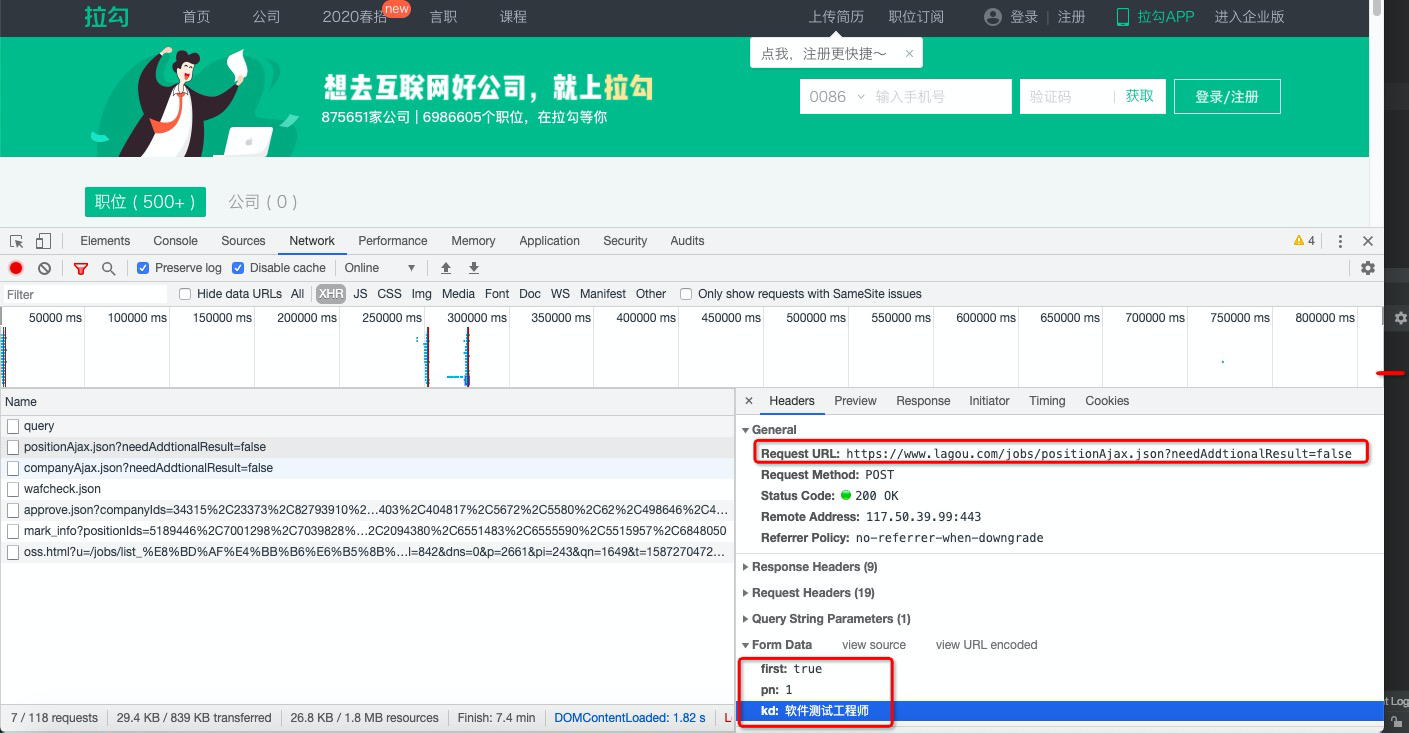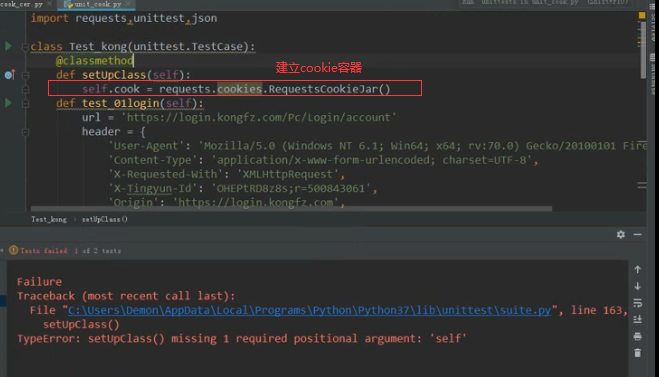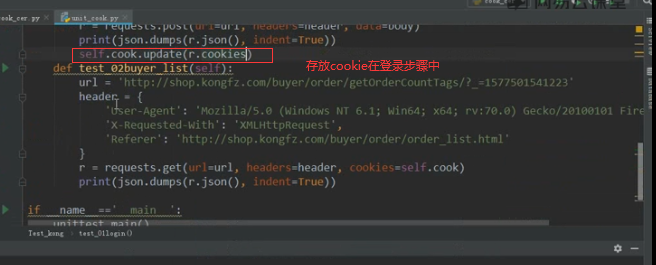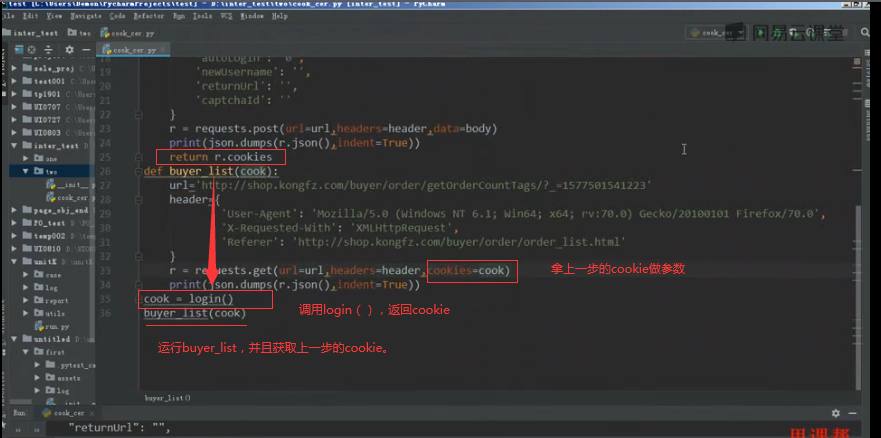requests安装
- 用pip安装requests模块
- pip install requests

一、Get的使用
格式:get(url, params=None, **kwargs)
Get常见查询参数
- req.status_code:响应状态码
- req.raw:原始响应体,使用r.raw.read()读取
- req.content:字节方式的响应体,需要进行解码
- req.text:字符串方式的响应体,会自动更具响应头部的字符编码进行解码
- req.headers:以字典对象储存服务器响应头,但是这个字典比较特殊,字典键不区分大小写,若键不存在,则返回None
- req.json():request中内置的json解码器
- req.raise_for_status():请求失败(非200响应),抛出异常
- req.url:获取请求的url
- req.cookies:获取请求后的cookies
- req.encoding:获取编码
import requests
url = 'https://www.baidu.com/s'
params = {
'Wd':'%E6%B5%8B%E8%AF%95',
'prefixsug':'ceshi',
}
header = {
'User-Agent':'Mozilla/5.0 (Macintosh; Intel Mac OS X 10_15_4) AppleWebKit/537.36 (KHTML, like Gecko) Chrome/80.0.3987.163 Safari/537.36',
}
cookie = {
}
data = requests.get(url=url,headers=header,params=params,cookies=cookie)
print(data.content.decode('utf8'))
断言:
assert data.json()['status']==False
Post请求参数
格式:post(url,data,json,…)
Post常见查询参数
- url:post请求地址
- data:body为application/x-www-form-urlencoded格式数据时传参入口
- json:body为json格式数据时传参入口
- headers:post请求需要header参数时传参入口

import requests,json
url = 'https://www.lagou.com/jobs/positionAjax.json'
params = {
'needAddtionalResult':'false'
}
header = {
'User-Agent':'Mozilla/5.0 (Macintosh; Intel Mac OS X 10_15_4) AppleWebKit/537.36 (KHTML, like Gecko) Chrome/80.0.3987.163 Safari/537.36',
'Content-Type':'application/x-www-form-urlencoded; charset=UTF-8'
}
body = {
'first':'true',
'pn':'1',
'kd':'软件测试工程师',
}
# requests 操作 # timeout超时时间2秒 verify 安全证书True要有安全证书,根据浏览器要求 indent 内容做序列化
value = requests.post(url=url,headers=header,params=params,data = body,timeout=2.00,verify=True,indent=True)
print(value.json())
data = value.json()
filename = 'filename'
x = json.dump(data,open(filename,'w'),ensure_ascii=False,indent=True)
y = json.load(open(filename,'r'))
print(y)
二、JSON模块
1、json.dumps()
- 用于将dict类型的数据转成str,因为如果直接将dict类型的数据写入json文件中会发生报错,因此在将数据写入时需要用到该函数
2、json.loads()
- json.loads()用于将str类型的数据转成dict。
- 与json.dumps()用法正好反过来。
3、json.dump()
- json.dump()用于将dict类型的数据转成str,并写入到json文件中。下面两种方法都可以将数据写入json文件
4、json.load()
- json.load()用于从json文件中读取数据
JSON数据处理
- import json
- json.dumps(req.json(),indent=True,ensure_ascii=False)
- req.json():json格式数据转换
- indent=True:json格式数据序列化
- ensure_ascii=False:json格式数据中文处理
三、请求超时、安全证书和内容序列化
请求超时 Requests.get中的timeout参数
Verify属性设置为False,安全证书免验证。 req= requests.get(url, verify=False)
内容做序列化 indent=True
# requests 操作 # timeout超时时间2秒 verify 安全证书True要有安全证书,根据浏览器要求 indent 内容做序列化 value = requests.get(url=url,headers=header,params=params,data = body,timeout=2.00,verify=True,indent=True)
四、COOKIE的处理
- 请求间的cookie传递。
- 函数间的cookie传递。
- Unittest框架下的cookie传递。
声明cookie容器对象:
- self.cookie = requests.cookies.RequestsCookieJar()
向容器中传递生成cookies:
- self.cookie.update(r.cookies
第一步

第二步

第三步

第四步


import requests,unittest,json class Test_CDN(unittest.TestCase): @classmethod def setUpClass(self): self.cookie = requests.cookies.RequestsCookieJar() def test_01login(self,*args): url = 'https://pagead2.googlesyndication.com/getconfig/sodar?sv=200&tid=gda&tv=r20200416&st=env' header = { "accept":"*/*", "accept-encoding":"gzip,deflate,br", "accept-language":"zh-CN,zh;q=0.9,en;q=0.8", "cache-control":"no-cache", "origin":"https://blog.csdn.net", "pragma":"no-cache", "referer":"https://blog.csdn.net/weixin_43665351", "sec-fetch-dest":"empty", "sec-fetch-mode":"cors", "sec-fetch-site":"cross-site", "user-agent":"Mozilla/5.0 (Macintosh; Intel Mac OS X 10_15_4) AppleWebKit/537.36 (KHTML, like Gecko) Chrome/80.0.3987.163 Safari/537.36", "x-client-data":"CK+1yQEIhrbJAQiktskBCMS2yQEIqZ3KAQinoMoBCMuuygEI0K/KAQi8sMoBCJe1ygEI7bXKAQiOusoB" } req = requests.get(url=url,headers=header) print(json.dumps(req.json(),indent=True)) self.cookie.update(req.cookies) return req.cookies def test_02input(self): url = 'https://me.csdn.net/api/external/user/getUserProfile?username=weixin_43665351' header = { "accept":"application / json, text / javascript, * / *; q = 0.01", "accept - encoding":"gzip,deflate,br", "accept - language":"zh - CN, zh;q = 0.9, en;q = 0.8", "cache - control":"no - cache", "content - type":"application / json", "origin":"https: // blog.csdn.net", "pragma":"no - cache", "referer":"https: // blog.csdn.net / weixin_43665351", "sec - fetch - dest":"empty", "sec - fetch - mode":"cors", "sec - fetch - site":"same - site", "user - agent":"Mozilla / 5.0(Macintosh;Intel Mac OS X 10_15_4) AppleWebKit / 537.36(KHTML, like Gecko) Chrome / 80.0.3987.163Safari / 537.36", } cookie = self.test_01login() print(cookie) req = requests.post(url=url,headers = header,cookies = cookie) print(json.dumps(req.json(),indent=True)) if __name__ == '__main__': unittest.main()
五、Token的处理
1.从响应中提取token值。
2.token值的使用方式。

import requests
key = requests.Session()
file = key.get('http://www.baidu.com')
print(file.cookies)
Requests-html
安装
pip3 install requests-html
导入
from requests_html import HTMLSession
Requests-html
使用
from requests_html import HTMLSession
req = HTMLSession()
params = {'query':'testing'}
w=r.get("http://www.sogou.com/web",params=params)

六、认证及SESSION的处理
身份认证的定义
- 身份认证是使用用户提供的凭证来识别用户。
- session会话保存,用来保持会话的状态;
- token是对用户进行授权。
- 身份认证和授权的关系:需要先获取身份信息才能进行授权
身份认证的类型
1、基本身份认证
HTTP Basic Auth是HTTP1.0提出的认证方式
客户端对于每一个realm,通过提供用户名和密码来进行认证的方式
当认证失败时,服务器收到客户端请求,返回401 UNAUTHORIZED,同时在HTTP响应头的WWW-Authenticate域说明认证方式及认证域身份认证的类型
import requests from requests.auth import HTTPBasicAuth url = '192.613.001.002' # 通过auth输入用户名和用户密码,来通过系统的验证 r = requests.get(url=url,auth=HTTPBasicAuth('user','password')) print(r.content)
2、netrc 认证
如果认证方法没有收到 auth 参数,Requests 将试图从用户的 netrc 文件中获取 URL 的 hostname 需要的认证身份
3、摘要式身份认证
digest authentication:在HTTP 1.1提出,目的是替代http 1.0提出的基本认证方式
SESSION的处理
1、requests库的session对象能够帮我们跨请求保持某些参数,也会在同一个session实例发出的所有请求之间保持cookies。
2、requests库的session对象还能为我们提供请求方法的缺省数据,通过设置session对象的属性来实现。
import requests key = requests.Session() file = key.get('http://www.baidu.com') print(file.cookies)
